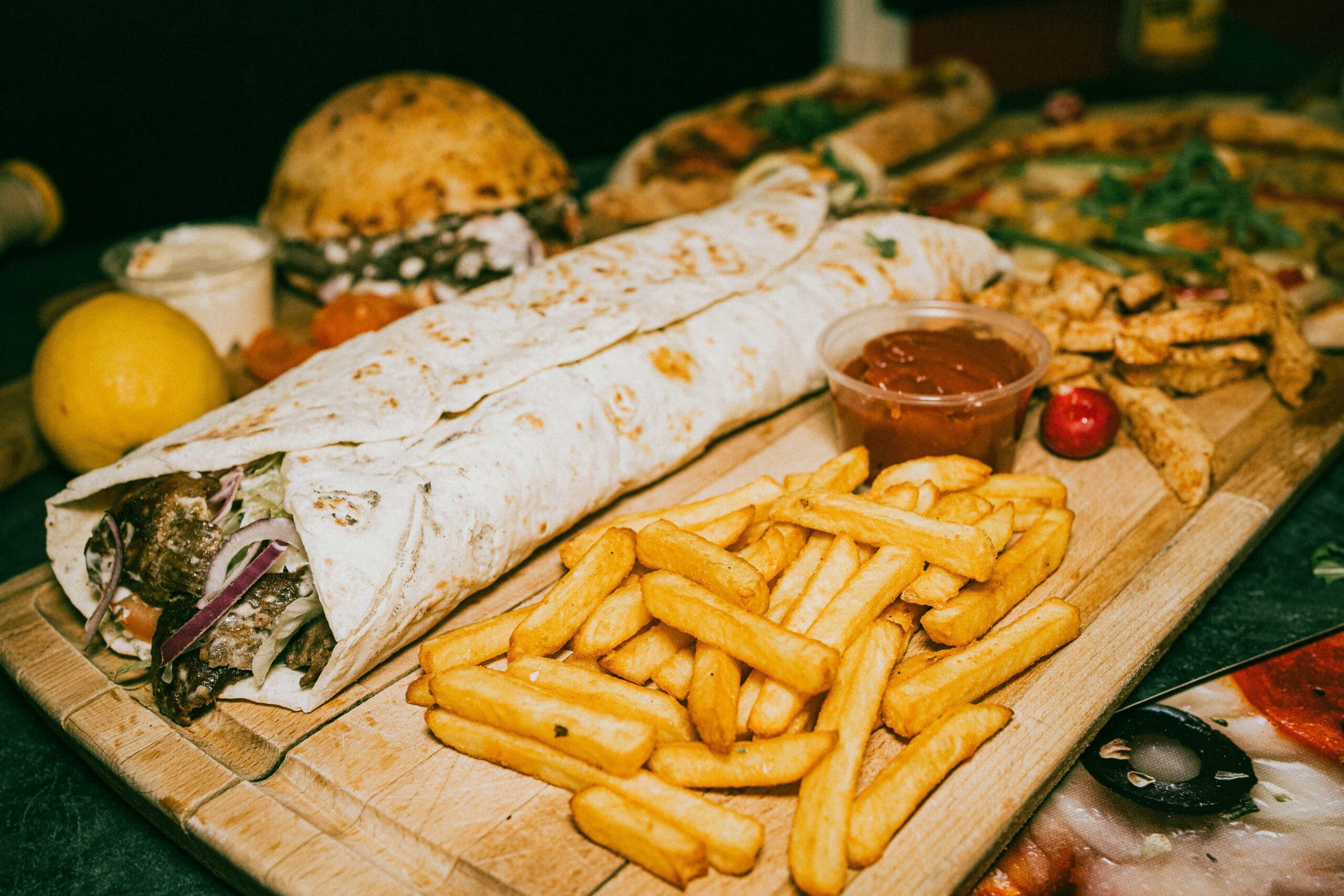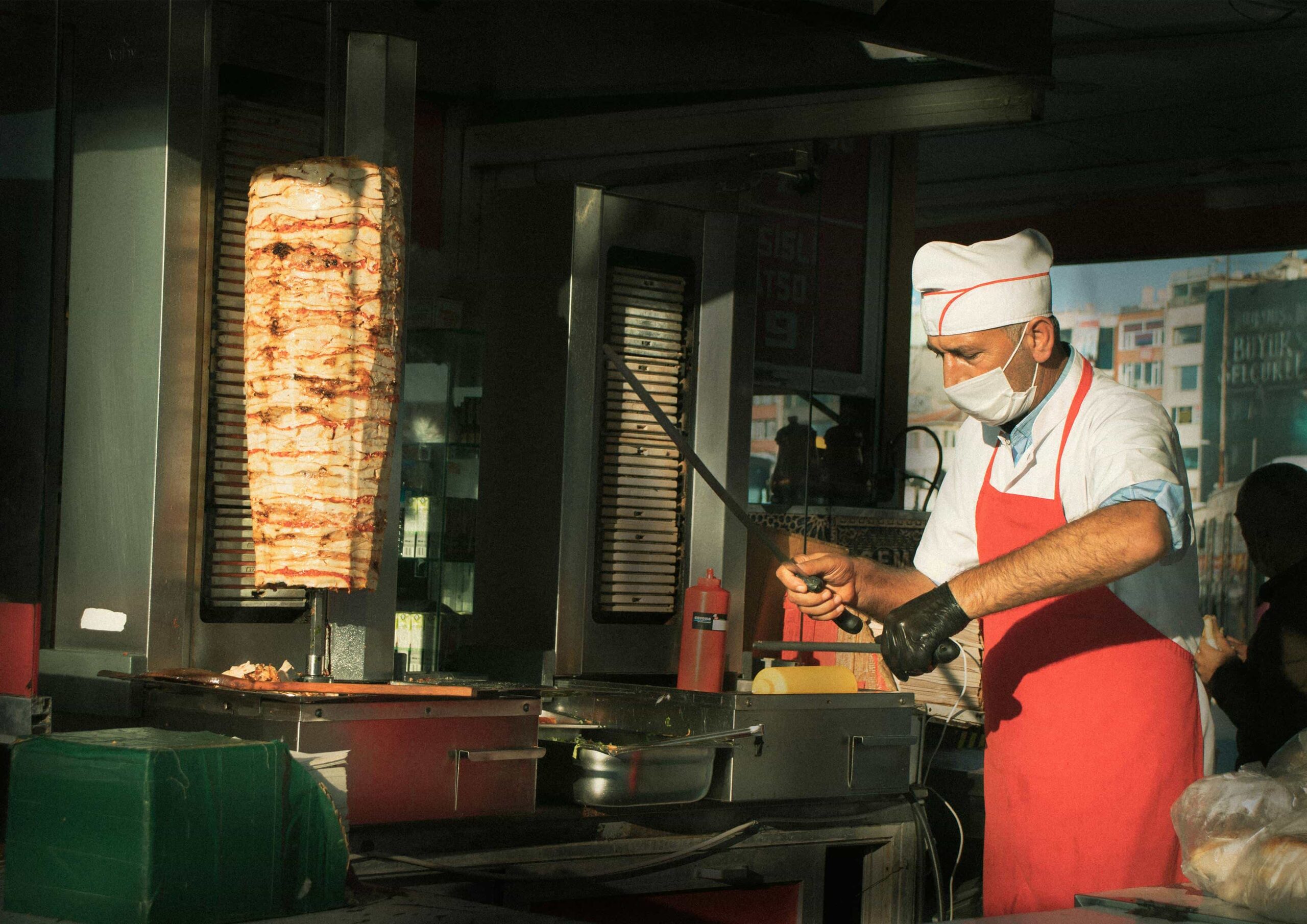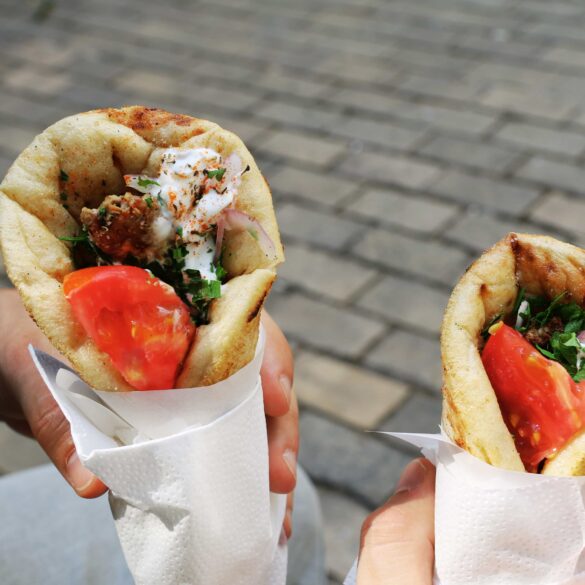Perfect Doner Kebab: Traditional Preparation Guide & Facts
Walking through the bustling streets of Istanbul three years ago, I experienced something that completely changed my understanding of what doner kebab should actually taste like. The aroma—that incredible blend of charred meat, warm spices, and wood smoke—drew me toward a small corner shop where an elderly Turkish man was skillfully carving paper-thin slices from a massive, golden-brown vertical spit. That first bite? Absolutely transformative.
Most people think they know doner kebab, but honestly, what we often get in fast-food joints barely resembles the authentic Turkish masterpiece. Having spent considerable time learning from traditional kebab masters and experimenting in my own kitchen, I’ve discovered that perfect doner kebab isn’t just about throwing seasoned meat on a stick—it’s an art form that requires patience, technique, and deep respect for centuries-old traditions.
The Rich Cultural Heritage Behind Doner Kebab
According to culinary historians1, doner kebab originated in the Ottoman Empire during the 19th century, though the exact inventor remains debated. What fascinates me most is how this simple concept—meat cooked on a vertical rotating spit—revolutionized street food culture across multiple continents. The word “doner” literally means “turning” in Turkish, which perfectly captures the hypnotic rotation that creates those beautifully caramelized, crispy outer layers.
Turkey Culinary Fact
Turkey produces over 300,000 tons of doner kebab annually, making it one of the world’s largest producers of this iconic dish. The Turkish government has even established official standards for authentic doner preparation, recognizing its cultural significance as a national treasure.
The cultural journey of doner kebab tells a fascinating story of migration and adaptation. When Turkish immigrants began establishing communities across Europe in the 1960s, they brought this culinary tradition with them2. What happened next was pure food evolution—each culture adapted the basic concept to local tastes and ingredients, creating wonderful variations like German döner, Greek gyros, and Middle Eastern shawarma.
Here’s what really strikes me about traditional doner preparation: it’s simultaneously simple and incredibly complex. The basic principle—marinated meat cooked on a vertical spit—seems straightforward until you dive into the nuances. The angle of the spit, the fire temperature, the timing of each turn, the thickness of each slice—every detail matters. Master kebab makers spend years perfecting these skills, and honestly, watching them work is like witnessing edible poetry in motion.
Why Vertical Cooking Changes Everything
The vertical rotation technique isn’t just for show—it serves multiple culinary purposes that directly impact flavor and texture. As the meat slowly rotates, the outer layer develops that coveted crispy, caramelized crust while the interior remains incredibly tender and juicy. The rendered fat continuously bastes the meat below, creating layers of flavor that horizontal cooking simply can’t achieve3.
During my time learning from Mehmet, a third-generation kebab master in Ankara, he explained something that completely changed my understanding: “The spit must be perfectly balanced, the fire positioned just right, and the meat carved at the exact moment when the outer layer reaches peak perfection.” This isn’t fast food—it’s slow food masquerading as quick service.
Traditional Preparation Methods and Techniques
Let me be completely honest—the first time I attempted to make doner kebab at home, it was a disaster. I thought I could shortcut the process, skip the overnight marination, and somehow achieve restaurant-quality results. What I got was tough, poorly seasoned meat that barely resembled authentic doner. That failure taught me to respect the traditional methods that have been refined over centuries.
The Art of Meat Selection and Preparation
Traditional doner kebab uses a specific combination of meats that creates the perfect balance of flavor and texture. According to authentic Turkish recipes4, the ideal mixture combines lamb and beef in carefully calculated proportions. The lamb provides richness and distinctive flavor, while the beef adds structure and helps the meat hold together during the long cooking process.
Traditional Meat Ratio Formula
Classic Turkish doner uses approximately 60% lamb shoulder and 40% beef chuck. The lamb should have good marbling but not be overly fatty, while the beef provides the protein structure needed for proper binding. This ratio has been perfected over generations and produces the most authentic flavor profile.
The meat preparation process requires patience and technique. Each piece must be cut to specific dimensions—typically 1-2 inches thick for optimal cooking. What really matters is the grain direction; cutting against the grain ensures tender results, while maintaining consistent thickness allows even cooking throughout the massive kebab cylinder.
| Meat Type | Percentage | Cut Selection | Purpose |
|---|---|---|---|
| Lamb Shoulder | 60% | Well-marbled, boneless | Flavor and richness |
| Beef Chuck | 40% | Lean with some fat | Structure and binding |
Essential Marinade Components
The marinade is where the magic really happens. Traditional Turkish doner marinade isn’t just about adding flavor—it’s about transforming the meat’s texture and creating those complex layers of taste that make authentic doner so memorable. After experimenting with dozens of variations, I’ve learned that each ingredient serves a specific purpose in this alchemical process.
- Yogurt: The lactic acid tenderizes the meat while adding subtle tang and helping other flavors penetrate deep into the fibers
- Olive Oil: Carries fat-soluble flavors and prevents the meat from drying out during the long cooking process
- Onion (grated): Provides natural enzymes that break down proteins and adds sweet, savory depth
- Garlic: Essential for authentic flavor, but must be balanced to avoid overwhelming the meat
- Paprika: Adds color and mild pepper flavor without excessive heat
- Cumin: Provides earthy, warm notes that define Turkish cuisine
The marinade timing is absolutely crucial. Research shows that meat needs minimum 4 hours for basic flavor penetration, but 12-24 hours produces optimal results5. I’ve found that 18 hours seems to be the sweet spot—long enough for deep flavor development but not so long that the acid breaks down the meat’s structure.
Equipment and Setup Requirements
While most of us don’t have access to commercial vertical rotisseries, you can create excellent doner kebab with adapted equipment. The key is understanding the principles behind vertical cooking and finding creative ways to replicate those conditions in a home kitchen.
For authentic results, you’ll need a vertical rotisserie attachment for your grill, or alternatively, you can use a large vertical roasting setup. The crucial elements are consistent rotation, proper heat distribution, and the ability to carve the meat as it cooks6.
- Vertical rotisserie system (commercial or adapted home version)
- Sharp, long-bladed knife for carving
- Heat source positioned at proper angle (typically 45-60 degrees)
The setup process requires careful attention to balance and heat distribution. The meat must be layered and compressed properly to ensure even cooking and prevent pieces from falling off during rotation. This is definitely where having experienced guidance makes a huge difference—my first attempts resulted in more meat on the ground than on the spit!

Step-by-Step Perfect Doner Preparation Process
After years of trial and error—and honestly, quite a few culinary disasters—I’ve developed a systematic approach to creating restaurant-quality doner kebab at home. The process requires patience and attention to detail, but the results are absolutely worth the effort. Let me walk you through each crucial step.
Phase 1: Meat Preparation and Marination
Start with your meat selection 24 hours before you plan to cook. This timing isn’t arbitrary—it’s based on the science of how marinades penetrate protein fibers and develop complex flavors. I’ve found that beginning this process on a Saturday morning for Sunday dinner creates the perfect timeline.
Critical Timing Alert
Never marinate for less than 12 hours or more than 36 hours. Less time produces insufficient flavor penetration, while longer periods can break down the meat’s structure, resulting in mushy texture. The optimal window is 18-24 hours for perfect results.
The meat preparation sequence matters enormously. First, trim excess fat but leave enough for flavor and moisture—about 20% fat content is ideal. Cut the meat into uniform pieces, approximately 1.5 inches thick. This specific thickness ensures even cooking throughout the massive kebab cylinder while maintaining structural integrity during the long cooking process7.
- Combine yogurt, olive oil, grated onion, and spices in a large bowl
- Add meat pieces and massage marinade thoroughly into every surface
- Cover tightly and refrigerate for 18-24 hours, turning occasionally
Phase 2: Assembly and Mounting
The assembly process is where doner kebab preparation becomes truly artistic. Each piece of marinated meat must be carefully layered and compressed to create a uniform cylinder that will cook evenly. I remember watching a master kebab maker in Berlin who could assemble a 40-pound doner in under 20 minutes with perfect precision—absolutely mesmerizing to observe.
Begin by threading the largest, most substantial pieces onto the spit first. These form the structural foundation that supports the entire kebab. The meat should be packed tightly but not compressed so much that it becomes dense. You want enough compression to hold everything together during rotation, but sufficient space for heat circulation8.
| Assembly Stage | Technique | Key Points | Common Mistakes |
|---|---|---|---|
| Foundation Layer | Largest pieces first | Structural integrity | Using small pieces |
| Middle Layers | Alternating sizes | Even distribution | Uneven layering |
| Top Section | Secure capping | Prevents falling | Loose assembly |
Phase 3: Cooking and Temperature Control
The cooking phase requires constant attention and adjustment. Unlike conventional grilling where you can set it and forget it, doner kebab demands active monitoring throughout the entire process. The heat source should be positioned to create a gradual temperature gradient—hottest at the bottom, cooler at the top.
Start with high heat to develop that crucial initial crust, then reduce to medium for the long, slow cooking process. The ideal internal temperature progression moves from outside to inside, creating distinct layers of doneness that produce the characteristic texture contrasts in each slice9.
- Initial high heat (450-500°F) for 15-20 minutes to develop crust
- Reduce to medium heat (325-350°F) for main cooking phase
- Maintain consistent rotation speed (approximately 4-6 RPM)
- Monitor internal temperature, targeting 160°F for food safety
Regional Variations and Cultural Adaptations
What fascinates me about doner kebab is how different cultures have embraced and adapted this Turkish creation while maintaining its essential character. Having traveled extensively and tasted doner variations across multiple countries, I’ve discovered that each region adds its own unique twist while respecting the fundamental principles.
German döner kebab, for instance, has become a cultural phenomenon in its own right. The German version typically includes more vegetables and sauces, creating a more substantial sandwich-style meal. According to food culture researchers10, Germany now has over 16,000 döner kebab shops, making it one of the most popular fast foods in the country.
Modern Innovations and Health Considerations
The evolution of doner kebab in recent years has been remarkable to witness. While traditional methods remain the gold standard, modern innovations have made this incredible dish more accessible, healthier, and adaptable to various dietary requirements. As someone who’s experimented with both traditional and contemporary approaches, I find the balance between authenticity and innovation absolutely fascinating.
Nutritional Profile and Health Benefits
Contrary to popular perception, well-prepared doner kebab can be quite nutritious. The combination of lean meats provides high-quality protein, essential amino acids, and important minerals like iron and zinc. Research indicates that a typical doner kebab serving contains approximately 25-30 grams of protein11, making it an excellent post-workout meal.
| Nutrient | Amount per 100g | Daily Value % | Health Benefits |
|---|---|---|---|
| Protein | 26g | 52% | Muscle building, satiety |
| Iron | 2.8mg | 16% | Oxygen transport, energy |
| Zinc | 4.2mg | 28% | Immune function, healing |
| Vitamin B12 | 2.1µg | 35% | Nervous system, red blood cells |
The key to healthy doner kebab lies in preparation methods and portion control. When you make it at home, you control the fat content, sodium levels, and cooking methods. I’ve experimented with leaner meat cuts and reduced-fat marinades that maintain authentic flavors while improving nutritional profiles.
Dietary Adaptations and Alternatives
Modern doner kebab has evolved to accommodate various dietary preferences and restrictions. Having worked with several vegetarian and vegan friends to create plant-based versions, I’ve discovered that the key lies in replicating the texture and flavor complexity of traditional meat-based doner.
Plant-Based Doner Innovation
Seitan-based doner kebab has gained tremendous popularity, especially in European markets. When properly seasoned and prepared, it provides remarkably similar texture and flavor to traditional meat versions while offering complete plant-based nutrition.
- Chicken Doner: Lighter alternative using marinated chicken thighs for lower fat content
- Turkey Doner: Lean protein option popular in health-conscious communities
- Seitan Doner: Plant-based version that surprisingly captures traditional textures
- Jackfruit Doner: Naturally fibrous fruit that mimics pulled meat texture
The adaptation process requires understanding how different proteins behave under vertical cooking conditions. Research from food science departments12 shows that plant-based proteins need different marinade compositions and cooking temperatures to achieve optimal results.
Sustainable and Ethical Considerations
As someone deeply committed to sustainable food practices, I’ve become increasingly interested in the environmental impact of doner kebab production. The traditional meat-heavy approach raises questions about sustainability that modern practitioners are beginning to address through innovative sourcing and preparation methods.
Local sourcing has become increasingly important in authentic doner preparation. When I source lamb from local farms and work with regional suppliers, the flavor improvement is immediately noticeable. Plus, supporting local agriculture creates more sustainable food systems while often providing superior ingredient quality13.
Conclusion: Mastering the Art of Perfect Doner
Creating perfect doner kebab requires patience, respect for tradition, and willingness to learn from both successes and failures. After years of experimentation and learning from master chefs across multiple cultures, I’ve come to understand that this dish represents something much deeper than just seasoned meat on a spit—it’s a testament to culinary evolution and cultural exchange.
The techniques I’ve shared here represent centuries of refinement, but don’t be intimidated by the complexity. Start with small batches, focus on quality ingredients, and remember that every master chef once made their first imperfect doner kebab. The key is understanding the principles behind each step and adapting them to your available equipment and skill level.
Whether you’re drawn to traditional Turkish methods or interested in modern adaptations, the fundamental principles remain constant: quality ingredients, proper preparation, patience during cooking, and respect for the cultural heritage this dish represents. As you develop your own doner kebab skills, you’re joining a tradition that spans centuries and continues evolving with each new generation of passionate cooks.
References and Sources



